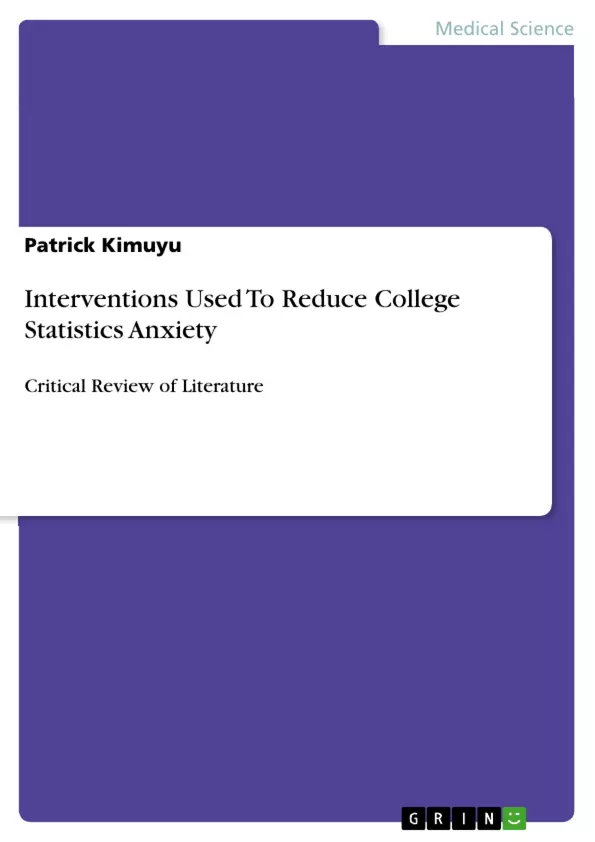This literature review aims at discussing the interventions that can reduce statistics anxiety among college students. To achieve this objective, a concise definition of statistics anxiety, as well as, the distinction between statistics anxiety and math anxiety is provided as the scientific rationale why the focus of this discussion is on interventions that reduce statistics anxiety, but not math anxiety in general.
Statistics anxiety has become an issue of concern in higher education due to its implications on teaching and learning. In retrospect, the trends of statistics anxiety are quite alarming. This aspect is evidenced by Onwuegbuzie and Wilson (2003) who report that statistic anxiety affects 80% of behavioral and social sciences students. They also report that most degree programs require students to enroll in quantitative research and statistics courses as part of their training. These statistic courses are reported to evoke anxiety-provoking experiences among students. Similarly, Macher et al. (2013) reaffirm that statistics courses have been found to be the major source of anxiety in student’s curriculum. Further evidence is provided by Dykeman’s (2011) study which investigated the levels of anxiety between students in statistic courses and those in other education courses. Results of this study revealed that statistics students had lower self-efficacy (p<.01) and higher levels of anxiety (p< .05) compared to other students.
As such, research on statistics anxiety has focused on the causes, as well as the statistics anxiety-reducing interventions. In this context, it is worth noting that statistics anxiety, as a construct, is different from math anxiety, which has been discussed extensively by researchers. Factor analysis reveals that statistics anxiety comprises of six dimensions: fear of statistics teacher, interpretation anxiety, computational self-concept, worth of statistics, fear of asking for help, and test and class anxiety. In contrast, mathematics anxiety has one dimension: fear of mathematics.
Inhaltsverzeichnis (Table of Contents)
- Introduction
- Defining Statistics Anxiety
- Distinguishing Statistics Anxiety from Math Anxiety
- Antecedents of Statistics Anxiety
- The Need for Intervention
- Interventions for Reducing Statistics Anxiety in College Students
- Use of Live Vicarious Experience Presentation
- Value-Reappraisal
- Use of Humor
- Use of Instructor Immediacy
- Religious Motivation
- Use of Multifaceted Teaching Framework
- In-Class Collaborative Problem Solving
- Combined Instructional Strategies
- Summary of Literature on Statistics Anxiety Interventions
Zielsetzung und Themenschwerpunkte (Objectives and Key Themes)
This literature review aims to discuss interventions that can reduce statistics anxiety among college students. The objective is achieved by providing a concise definition of statistics anxiety and distinguishing it from math anxiety, thereby highlighting the focus on interventions specifically for statistics anxiety.
- Defining and distinguishing statistics anxiety from math anxiety
- Exploring the antecedents of statistics anxiety
- Reviewing various interventions for reducing statistics anxiety
- Analyzing the effectiveness of different intervention strategies
- Providing insights into the impact of statistics anxiety on college students
Zusammenfassung der Kapitel (Chapter Summaries)
The introduction highlights the growing concern about statistics anxiety in higher education, emphasizing its negative implications for teaching and learning. The chapter presents statistics on the prevalence of statistics anxiety and its impact on students in behavioral and social sciences programs. The need for effective interventions to reduce statistics anxiety is also stressed.
The chapter defines statistics anxiety as a form of anxiety triggered by encountering statistics. It differentiates statistics anxiety from mathematics anxiety, emphasizing the unique cognitive aspects of statistics anxiety. The chapter cites research on the antecedents of statistics anxiety, including factors like instrument anxiety, failure, and negative experiences with statistics.
The chapter explores various interventions designed to reduce statistics anxiety among college students. It examines the effectiveness of different strategies such as live vicarious experience presentation, value-reappraisal, humor, instructor immediacy, religious motivation, multifaceted teaching frameworks, in-class collaborative problem solving, and combined instructional approaches.
Schlüsselwörter (Keywords)
The main keywords and focus topics of the text include statistics anxiety, mathematics anxiety, interventions, college students, teaching and learning, research, and cognitive processes. The text also explores various intervention strategies such as live vicarious experience presentation, value-reappraisal, humor, instructor immediacy, religious motivation, and multifaceted teaching frameworks.
- Quote paper
- Patrick Kimuyu (Author), 2016, Interventions Used To Reduce College Statistics Anxiety, Munich, GRIN Verlag, https://www.grin.com/document/384371



